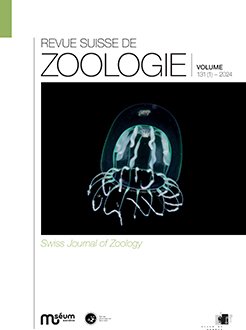In the summer of 2022, during a survey of the juniper forests of the Hezar Masjed Mountains, the entomological team of the Ferdowsi University of Mashhad (Iran) found a species of the genus Chlorophorus Chevrolat, 1863 close to C. elaeagni Plavilstshikov, 1956. After closer examination it appeared to represent a new species, which is described here as C. ahmadi sp. nov. The new species is a pest of live Juniperus polycarpos K. Koch var. turcomanica (B. Fedtsch) R. P. Adams (Cupressaceae) trees.
INTRODUCTION
We describe a new species of Cerambycidae of the genus Chlorophorus Chevrolat, 1863 discovered in the NorthEast of Iran in the Juniperus forests of Hezar Masjed Mountains, north of Khorasan Razavi province. A research project in this region was designed and carried out with the aim of evaluating the feasibility of different biological, mechanical, and chemical control methods in the management of main pests and diseases of juniper trees. The arid and semi-arid areas of Northeast Iran with juniper habitats consist of about 3.4 million ha (Fadaei, 2020).
The new species was reared from live small trunks and branches of junipers.
MATERIAL AND METHODS
Part of the specimens of the new species were collected inside the pupal cell on Juniperus branches or small trunks, the rest was obtained from rearings of the same wood.
The binocular microscope used to study the insects was a Wild M3, with magnifications of 10x6, 10x16 and 10x40. The pictures of prepared specimens were taken using a Canon 5D Mark II digital camera with a Nikkor EL 75, 5.6 mm optical zoom; they were stacked with Zerene Stacker.
Chlorophorus ahmadi sp. nov.
Figs 1, 2
Type material: Holotype: 1 male: Iran, Khorasan prov., Hezar Masjed Mountain, VI.2022, ex larva Juniperus polycarpos var. turcomanica (Coll. P. Rapuzzi); Paratypes: 3 males and 5 females with same data as the holotype (Coll. P. Rapuzzi).
Description: Length: males 17.0-18.0 mm (holotype: 17.5 mm), females 17.0-20.0 mm; width 2.6 mm. Body black. Dorsal surface covered with grey-green pubescence; ventral surface with pubescence ashy. Head longer than large; frons square, with thin and long shiny medial line; head, except furrow, entirely covered with short recumbent ashy bristles. Antennal tubercules closely separated, only slightly prominent, separated by shiny medial furrow. Antennae rather short, reaching basal third of elytra when extended posteriorly; third to fifth joints with dense fringe of light bristles on inner side, similar bristles restricted to apex on sixth joint. Pronotum longer than wide, with sides rounded; slightly narrower apically than basally; surface entirely covered with greenish pubescence consisting of strong, recumbent, short bristles, the latter oriented backwards; punctation consisting of strong and large punctures visible below pubescence.
Scutellum as long as wide, covered with ashy pubescence; apex rounded.
Elytra elongate, slightly constricted subapically; apex obliquely truncate, with small tooth on external side; entire surface homogeneously covered with dense greenish pubescence, the latter consisting of recumbent, short, strong bristles. Legs long, black, covered with greenish pubescence; with few scattered long erect black bristles distributed more densely on femora and tibiae of hind legs.
Differential diagnosis: The new species strongly resembles Chlorophorus elaeagni Plavilstshikov, 1956, a widespread species known from Europe (Caucasus: Azerbaijan), Southern Russia and Middle Asia (Turkmenistan, Uzbekistan, Kazakhstan and Kirgizia; Kadyrov et al., 2016; Karpiński et al., 2018). Chlorophorus elaeagni was described from Urda (West Kazakhstan) and its biology is associated with various deciduous trees and shrubs (Elaeagnus, halimodendron, Caragana, and Robinia; Kadyrov et al., 2016). The new species is easily distinguished from C. elaeagni as follows: 1) pronotum shorter and more globular in both sexes, with the lateral margins more rounded;
2) scutellum as long as wide, rounded at apex (in C. elaeagni longer than wide, with apex acuminate); 3) elytral apex more truncate and with a small tooth externally (the latter missing or at most very small in C. elaeagni); 4) shoulders possessing a small carina (missing in C. elaeagni); 5) body pubescence grey-green (instead grey-yellow in C. elaeagni); 6) antennae and legs shorter and stouter than in C. elaeagni.
Etymology: We dedicate the new species to Ahmad Baradaran Sirjani, husband of author Lida Fekrat, who passed away recently.
CONCLUSIONS
The area where the new species was discovered has been poorly investigated so far. Considering the relative richness of its vegetation cover, dominated by the broadleaved Pistacia vera L., 1753 (Anacardiaceae) and the conifer Juniperus polycarpos K. Koch var. turcomanica (B. Fedtsch) R. P. Adams (Cupressaceae), it is very likely that other interesting findings will be made there in the future.
ACKNOWLEDGEMENTS
We sincerely thank the Deputy of Research and Technology of Ferdowsi University of Mashhad for providing experimental facilities and laboratory space for this project.
Financial support from the General Department of Natural Resources and Watershed Management of Khorasan Razavi Province is highly appreciated. We are very grateful to Dr Maurizio Gigli (Rome, Italy) for taking and arranging the pictures of the present publication.
This is an open access article distributed under the terms of the Creative Commons Attribution License (CC BY 4.0), which permits unrestricted use, distribution, and reproduction in any medium, provided the original author and source are credited (see https://creativecommons.org/licenses/by/4.0/).






